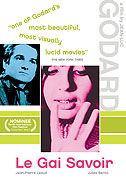
Inhalte(1)
While alone in an abandoned television studio, two militants, Emile Rousseau (Jean-Pierre Léaud) and Patricia Lumumba (Juliet Berto), have a discourse on language. Referring to spoken word as "the enemy" – the weapon used by the establishment to confuse liberation movements – the two deconstruct the meanings of sounds and images in an attempt to ‘return to zero’ and truly experience the joy of learning. (Verleiher-Text)
(mehr)Kritiken (1)
In order to find a solution, whether it is chemical or political, it is necessary to dissolve. Dissolve hydrogen, dissolve parliament. Here, we are preparing to dissolve image and sound. The motto "decomposition, reduction, substitution, and reconstitution" of images and sounds into new forms is inherent in Godard's entire work, but after May 68, there was also a strong desire to discover new forms of social and political expression. However, this effort was not separate from the initial motto! Godard is thus fully the heir to the spirit of the May revolt in its innovative idea that man changes through action (for example, by participating in a new form of political self-expression and self-control, for example, the famous motto "autogestion" - self-management). Man does not change only after the revolution, but before it and through it, and the revolution completes itself only with the changed individual. Joy of Learning is the film equivalent of the same thing - this film is not the finished result of the author's reflections on film, but a 95-minute-long self-reflexive process in which the author seeks and constantly (re)formulates the relationship between image and sound, film and society (here, it is necessary to mention the touching desire with which Godard believed that a revolutionarily created film could be one of the building blocks of the revolution - see references to the magazine Cahiers de Cinema, other filmmakers, etc.). This film is thus not a perfectly closed structure unified by a single meaning, but it has a radically open structure that allows it to simultaneously convey a multitude of different messages and experiment with itself, change itself, and thereby prepare for new tasks that will lie ahead in the future for such a discovered film.
()